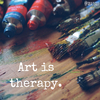Making Art Work: Sketching for Efficiency (Part One)
Sketching for Efficiency, Part One: Your Drawing Kit
As we help kick off #drawgust2020, the team at thalo wanted to offer some helpful hints and tips on how to get the most out of drawing this year! In this series, we'll be talking about different kinds of ways to draw, as well as showcasing different styles, techniques and tools you can use to get the best out of your work!
Having a reliable drawing kit can make all the difference! Being able ot store, archive and display your drawings is important, as well as having a good breadth of reliable tools will aid in creating an ideal drawing kit that can accompany you wherever you choose to sketch, whether it is outside in nature or at your work station!
Your Drawing Pad:
Choosing your ideal drawing pad relies heavily on your drawing prefernce. If you prefer to draw out in the open and have a smaller sketching style, a travel-sized drawing pad ranging from 5.5" x8.5" to a 6"x9" size will help greatly in allowing you to take your work with you on trips out to nature and beyond!
On the other hand, if you prefer to draw more loosely and in larger sections in your studio, then you may want to spring for a larger pad, anywhere between 11"x14" to 14" x 17" (or even larger) to get the full breadth of your illustrations.
Another important factor to take into account is the kind of paper you want to draw on. Are you a fan of lighter type of surface, like Color Pencil or Marker Paper? Or do you like working on a heavier Bristol Vellum? Do you like bright white sheet color, or do you like having midtones for your sketches? Sometimes it helps to get a paper sampler to choose what paper you like before committing to a full pad!
A fun thing that some drawing pads have are interchangeable page designs (as shown in the above photo). These can allow for you to remove, rearrange or add different pages to your sketchbook! It comes in super handy when you are trying to collect and consolidate your best sketches into one drawing pad.
Drawing Tools:
The second most important aspect to drawing is your tools! Are you a fan of pencil sketching, pens only, color pencil, or a combination of two or three (or all of the above)?
Pencils: Do you like the sharp marking and tight control of a 4H leaded pencil? Or do you appreciate the charcoal-like smear and the ability to capture mid-tones of a softer 4B leaded pencil? Do you prefer technical mastery with a mechanical pencil or do you rather use a traditional lead-holder and rotary sharpener? If you are in the studio you may be able to have your pick of the litter, but if you have a preference, it will help you with having a go-to tool for when you are out and about sketching in the world and have to travel light.
Charcoal: Charcoal can be great for stationary places, but can be a bit messy in transport, esepcially on the hands! That's not to say that you can use paper towels, stick holders or other tools to make your drawings less smear-proof and travel-friendly!
Pens: Do you like the technical control of a fine-lined pen? Or do you appreciate the organic, looseness of a standard rollerball pen? Or, are you a skilled hand to avoid the colleciton of seven different line weights of illustration pens and opt for either a brush nip or an inkwell and inking brush? Having a brush-tip pen can make all the difference when drawing out in the world, but it always helps to have a selection when you are at your desk!
Sharpener: You can always get a standard sharpener, or get a rotary tool sharpener for lead sticks! Or, if you prefer the older ways of drawing, you can use a crafting blade to sharpen your leads.
Erasers: Erasers come in all shapes and sizes, and choosing the right one for yourself depends on your drawing style and preference. If you prefer precise highlights with your shading drawings, getting an angled eraser or using a pencil-topped eraser can be helpful. Or, if you prefer to remove your underlines, a trusty dusty kneaded rubber eraser can make all the difference!
Other Tools: There are plenty of great options if you wish to expand your drawing kit tools beyond the standard "pen, pencil, etc." list. Paint markers can be a great way to add highlights to your illustrations, as well as a select color pencil or pen/paint marker. A pocket-sized ruler can make a great option for varying your lineweights and creating some mechanical elements to your organic drawings.
Hopefully this is helpful in pointing you in the right direction to get started in working with your drawing materials.
Stay tuned to thalo.com for more installments of "Sketching for Efficiency" where we will be discussing more detailed techniques, exercises and tricks on improving your drawing ability.
You can get all kinds of supplies shown in this article at https://legacyartsupply.com/ !








